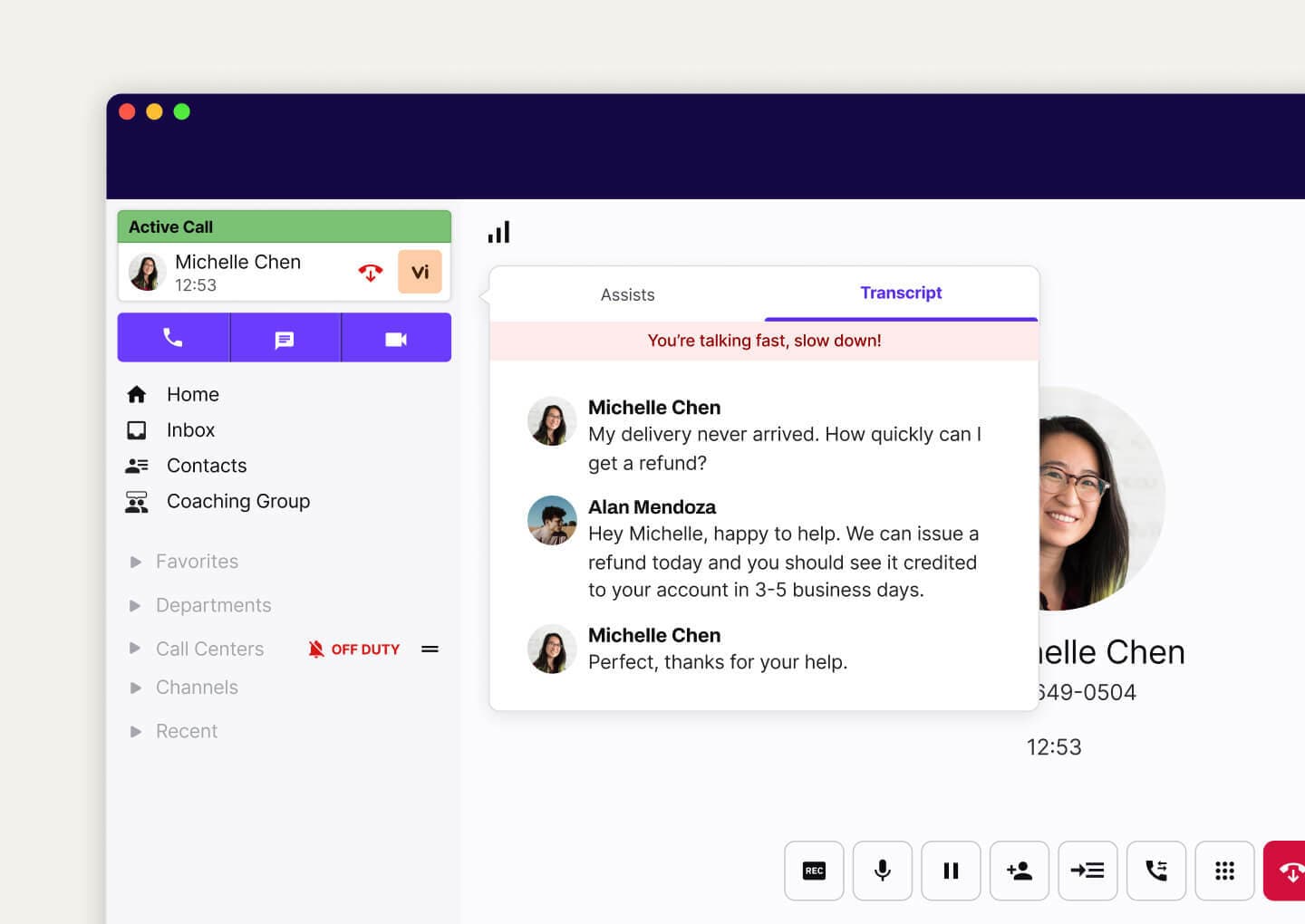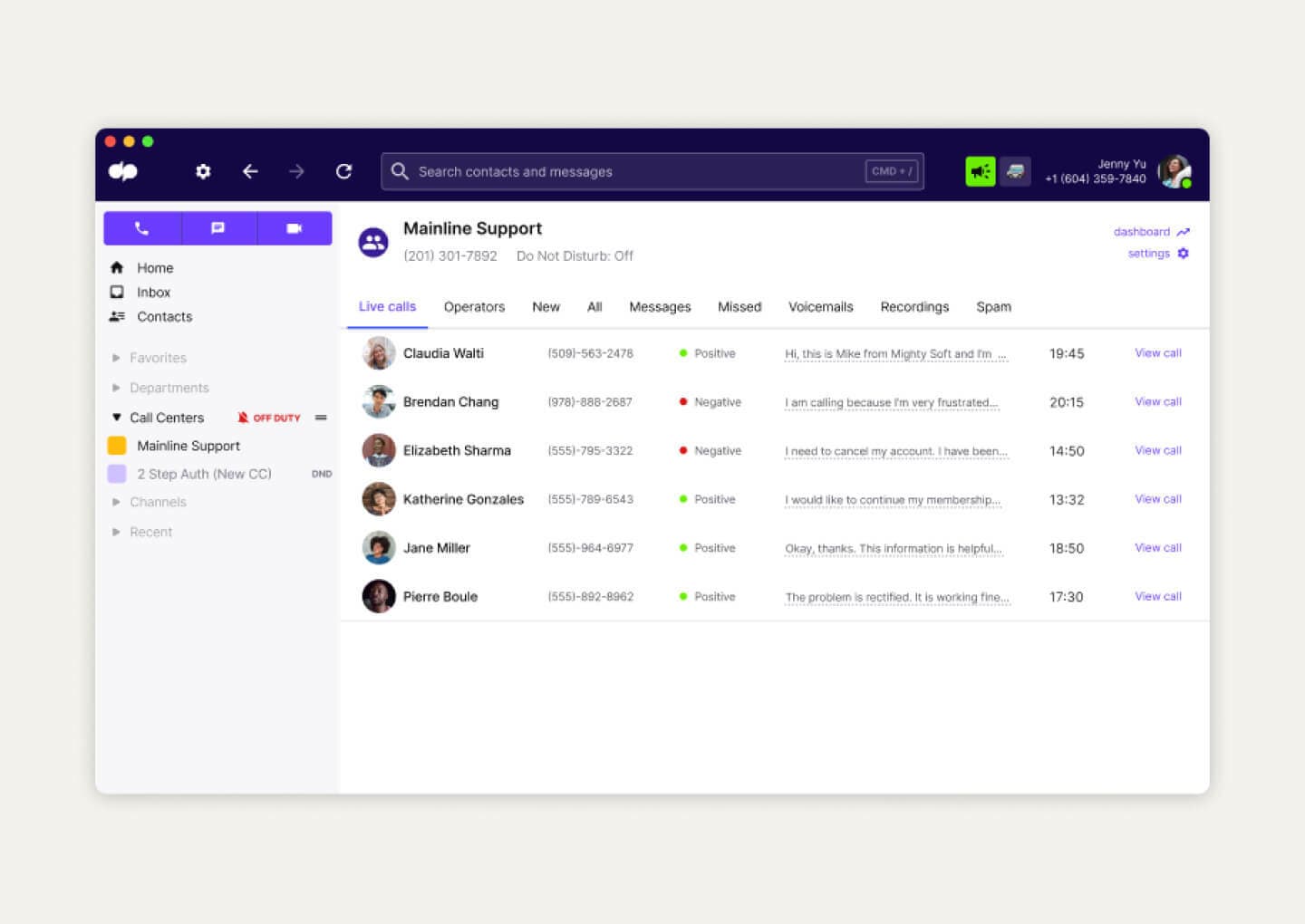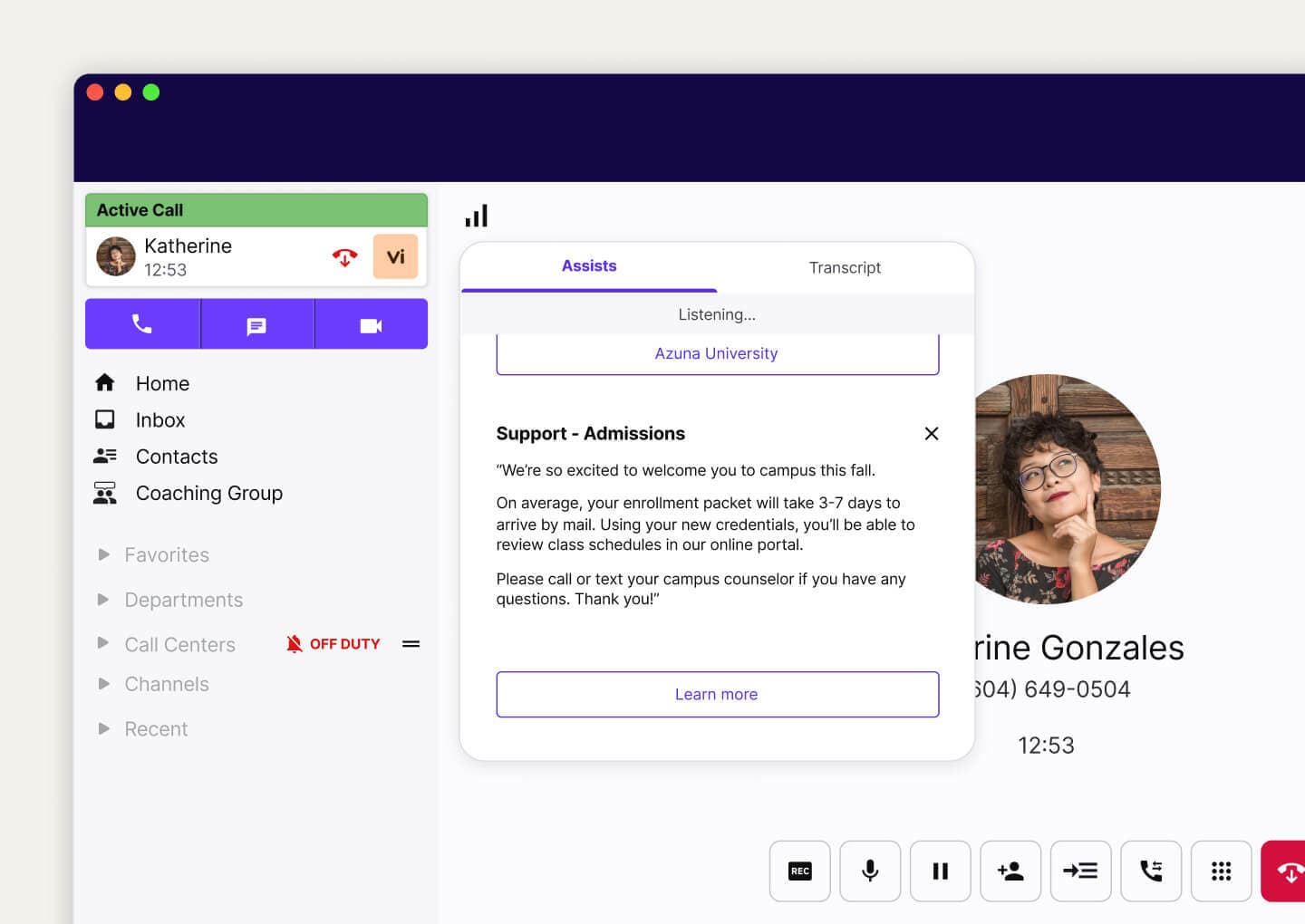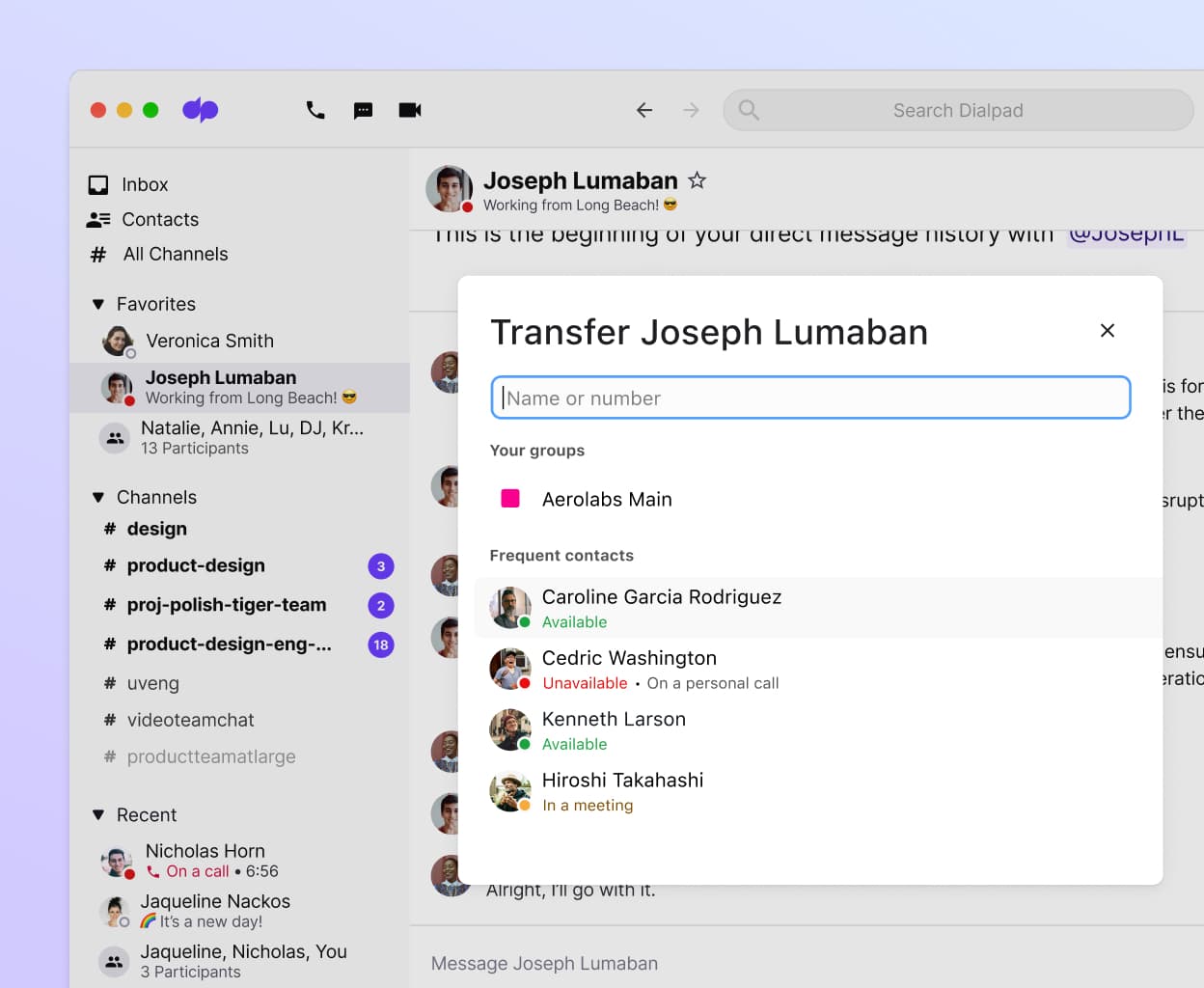Not your average chatbot
Conversational AI
Chatbots and virtual assistants are very helpful for automating some types of customer communications. But how is the average chatbot different from its more evolved cousin, conversational AI? Book a product tour to learn more!

What is conversational AI?
Conversational AI (artificial intelligence) uses natural language processing (NLP) and machine learning to essentially simulate natural-sounding conversations with computer programs.
Instead of having a rigid set of standard answers that responds to preset questions or inputs (like traditional chatbots), conversational AI can provide more varied, context-dependent responses.
Dialpad Ai Contact Center, for example, has a conversational AI feature (along with other unique AI solutions) that optimizes workflows for your agents, since it can handle most basic, straightforward questions from customers.
How does conversational AI work in Dialpad Ai Contact Center?
Chatbots used to "talk to" customers by essentially matching preset answers to preset yes/no or multiple choice questions.
Today, conversational AI takes things a step further. Here's what Dialpad Ai can do, for instance:
Search databases and FAQ pages for answers to customer questions.
Search
unstructured
sources of data, like PDF documents and past customer conversations—almost no other options on the market can do this!
Create intricate dialogues on your website, and even integrate rich media and video content.
Let you build automations and workflows in minutes—no coding needed.
And a lot more...
🤖 For example:
If a customer has a tough question about something that has never been covered on your company's FAQ page, but another customer has asked a similar question before, Dialpad can show an agent that past transcript to help them! Not only does conversational AI empower your human agents and customer support teams, it also improves customer satisfaction and creates a better customer experience overall, especially when complemented by other self-service options and automations.
More than just a conversational AI platform
So, how does Dialpad’s deep learning and AI technology make its contact center platform one of the best out there? Here are a few examples of what you can do with it.
Easy no-code setup
Incorporating things like text-to-speech algorithms into workflows doesn’t require as much specialist knowledge as you might imagine. With Dialpad, you can easily set up virtual agents and deploy a conversational AI solution just by dragging and dropping. You get an intuitive user experience without a super-complicated conversational AI system for developers.

Real-time transcription
With Dialpad's AI-powered natural language understanding, it can transcribe your voice conversations in real time. No more trawling through hours of recorded conversations trying to find that one thing someone said.

Live sentiment analysis
Dialpad can also do sentiment analysis—again, in real time. This way, supervisors who are overseeing multiple agents on active calls can quickly see if a call is going south, open up the live transcript to get more context, and then decide if they ned to jump in to help the agent.

Real-time agent assists
Even the best conversational AI platforms don't always have this, but real-time assists (aka. screen pops) are an important component in conversational AI contact center technology. With Dialpad, managers can create RTA (Real-Time Assist) cards with tailored notes on specific topics and set them to pop up automatically on agents’ screens when certain trigger words or phrases are spoken.

Omnichannel communications
Besides conversational AI functionality, Dialpad Ai Contact Center also lets agents and supervisors provide a full omnichannel experience, from a single pane of glass. Manage the AI chatbot straight to a website, send an instant or SMS message, and even handle social media messaging on platforms like Facebook Messenger and WhatsApp.

Custom call routing
Some conversational AI tools have robust routing features that help optimize call flows through things like interactive voice response (IVR) menus. With Dialpad, you can route incoming calls to the agent who's been idle the longest, by skill level, and more. Plus, the chatbot or conversational AI feature also lets your customers escalate the call, meaning they can easily route themselves to a human agent through a voice or video call if they decide that they're not getting what they need from conversational AI.

Enterprise-grade security
A good conversational AI platform provider should be secure. After all, it's handling conversations and may take down information from your customers, not to mention some industries have specific compliance requirements like GDPR and HIPAA. Dialpad helps you stay compliant with these and more, has in-meeting security controls, lets you set up custom data retention policies, and also has robust encryption standards.

Looking for a conversational AI tool?
Why not try a contact center provider that has it built right in? Book a product tour to see how it works now!
Examples of industry use cases for conversational AI
There are many examples of conversational AI use cases in different industries. Let’s look at a few ways it’s being used in healthcare, retail, HR, finance, and banking.
Conversational AI in healthcare
Conversational AI in healthcare can be used for a range of diagnostic, screening, and health management purposes.
Important conversational AI healthcare tools include symptom-reporting programs and intelligent appointment scheduling apps. These lessen the burden on healthcare providers by making sure patients see the right specialists and doctors aren’t overloaded with appointments that could've been resolved over a quick call or message.
Conversational AI in retail
In terms of retail, AI-powered virtual agents are great for providing support and guidance throughout the customer journey.
Not only can intelligent chatbots optimize your sales funnels by offering general information and promos or discounts, they can also reduce the volume of work for human agents by dealing with routine troubleshooting, after-sales support, and even customer surveying.
Conversational AI in HR
In very large global enterprises, there are a number of dedicated conversational AI recruiting and HR tools designed to help companies recruit, manage, and retain employees.
For HR departments looking to incorporate bots into their workflows, conversational AI chatbots can provide more efficient and engaging employee interactions and personalized conversational experiences.
When employees do need to contact HR, AI-enabled systems can empower HR team members by putting real-time, up-to-date information about policies, benefits, and more at their fingertips.
Conversational AI in finance and banking
When it comes to conversational AI for banks and other financial services providers, two key requirements are efficient (and effective) client service and a high level of security.
Thanks to natural language processing, virtual assistants can respond to bank account and other financial queries in seconds with personalized answers. This makes it possible for clients to receive an immediate and accurate resolution to routine requests such as canceling a lost or stolen credit card.
Considering how much conversational AI costs compared to expanding contact center staff— and the fact AI works 24/7, in multiple languages, and across multiple channels—it’s able to massively increase the scope of an organization’s support operations for a relatively low cost.
The benefits of conversational AI tools for different customer interactions
When it comes to improving customer interactions, three conversational AI benefits in particular stand out.
It ensures everyone’s needs are attended to—without overextending your team
While conversational AI can’t (and shouldn't) replace a customer service team and a good quality assurance program, it can help human agents do more work, more efficiently. Think of the suite of Dialpad conversation intelligence tools as a kind of conversational AI assistant that augments and enhances—rather than outright replaces—human agents.
Ideally, you'd use conversational AI and other automations to take simple requests and questions off your human agents' plates, and give them time back to focus on fewer inquiries that actually require a person to be involved.
It lets you provide 24/7 customer support
Because chatbots and AI-powered web chat tools run 24 hours a day, seven days a week, customers can always get help with their questions, even if your contact center is closed and your staff are all at home tucked up in their beds.
Conversational AI ecommerce solutions in particular have been popular because of the repetitive nature of the inquiries from these customers (like questions about purchases, refund or exchange policies, troubleshooting, and so on). To be fair though, any business or organization in any industry that interacts with an audience online regularly can benefit from conversational AI.
It lets you cover more languages
Do you work in an organization that does most of its internal communications in English but has an international, multilingual customer base? If so, you're probably already familiar with the challenges language barriers that can get between customers and your customer support team.
The good news is, chatbots and other AI conversational technology can speak multiple languages. Dialpad's IVR menu, for instance, can cover English, Spanish, French, Japanese, German, and more. This means customers who speak different languages are still able to navigate your IVR paths—without you needing to hire a translator or a ton of new team members who speak each of those languages.
How can a conversational AI platform improve your customer journeys?
There is a wide, wide range of conversational AI tools out there that all do slightly different things. In fact, according to Gartner, the conversational AI platform market currently constitutes an estimated 2,000 vendors worldwide.
We can help you narrow that search down a bit! If you're looking for an intuitive, easy-to-set-up conversational AI platform that you can integrate into your business processes quickly, why not check out Dialpad Ai Contact Center?
Not only do you get a fully integrated communications solution that lets you access telephony, instant + SMS messaging, video meetings, and contact center functionality—in a single interface—Dialpad's conversational AI is also a leader in the space, with its machine learning model having analyzed over two billion minutes of conversations.
Want to provide a better customer experience with conversational AI?
Book a product tour to see how easy it is to build chat workflows with the drag-and-drop tool in Dialpad Ai Contact Center!








